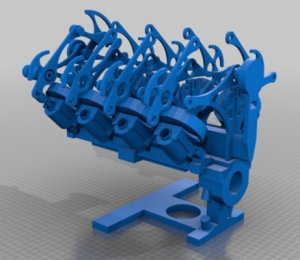
With the V8 Solenoid Engine, Sgt. Enochs is back with a continuation of a previous project he’d begun with a smaller engine. Creating a larger version, his hope is to fix issues and obstacles he ran into before with both timing and heating.
If you are interested in creating this engine yourself, we’ve supplied the list of what you’ll need as supplied by the maker, but as Enochs points out, it is a 3D printing project that’s more on the expensive side, and you’ll need to make a number of trips to different hardware stores to pick up all your parts.
Working to improve on where he had problems before, Enochs used larger solenoids for this engine for dispersing heat, and placed cooling fans on each piston. To nix the issue he was experiencing with timing, he explained that he used a SENSOFOIL touch sensor, but that has not been without challenge either.
“The particular SENSOFOIL sensor I purchased wasn’t as straightforward as I had hoped. The sensor had offset reading breakpoints that required some interesting programming. After that hurdle, it was exactly what a project like this needed,” says Enochs. “Some of you may notice tape on the sensor…that is because the part I designed doesn’t apply enough pressure on the sensor for the top half to read 100% accurately for every rotation.”
“I’ll redesign the part later,” he states.
He also found that the engine was too large for just one computer power supply. He was challenged as the Arduino began to reset itself randomly—or the power just cut off altogether because of the safety circuits.
“After that trial and error I grabbed a 650w power supply just for the solenoids and the 450 for the cooling system, Arduino and relay shield.”
- 4 x spool of mag wire (at about $27 each)
- 8 x cooling fans (at $8 each)
- Thermal paste tub ($25)
- Bearings ($20-$40)
- Arduino ($10)
- SENSFOIL ($20-$50)
- 2 x power supplies ($40 each)
- Wire, springs and other (less than $50)
This along with his previous projects, are quite remarkable considering that the military sergeant has completely taught himself the craft of digital design and 3D printing. For further reference, check out Enoch’s previous, much smaller, solenoid engine that runs a very high rate of speed also. See the videos below as well for further insight into this project. Is this a challenge you are interested in taking on? Discuss in the 3D Printed Large Solenoid Engine forum over at 3DPB.com.